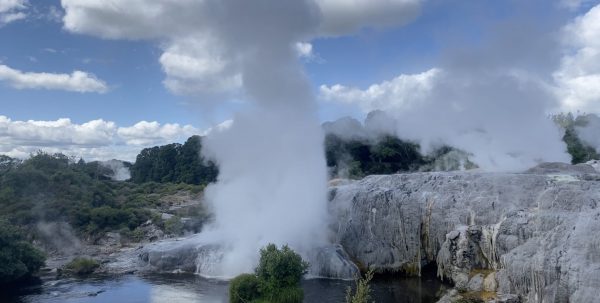Before we entered the reserve, we did see Pohutu erupting from the same parking lot as yesterday. Looked like it might have been near the start, as it was quite tall.
Inside Te Puia, before you can wander about watching geysers you must first take the 1-1/2 hour tour. We paid our dues. Wasn't a total waste of time, as did get to pass through the kiwi house, where we saw a couple of them wandering about in dark enclosures.
When we finally got to see geysers, Pohutu was in eruption. It continued to erupt for the next 20 minutes. About ten minutes after that, while we were at the high viewing platform, I saw Mahanga splash. This turned out to be the start of a series of eruptions. Every minute or so for the next ten minutes there was an eruption lasting 20 to 40 seconds long, with heights from three to six meters.
Shortly before the series ended, Te Tohu/Prince of Wales Feathers started erupting again. Pohutu started up about 25 minutes later. Then, about six minutes later, another Mahanga series started. The Pohutu eruption lasted about 41 minutes.
Based on our observations through the rest of the day, Mahanga has a series starting about every 35 to 45 minutes, and it is active for about ten minutes. The first activity of the series was usually a splash or two down in the vent, followed by a small eruption, maybe 2-3 meters high. Then the eruptions reached the full height, with the last of the series not much different than any of the others. The indication that it is the end of the series was having several minutes elapse without activity.
During this time, we were checking on Kereru. Every time it seemed to be calm, with a little steam coming from the vent, and no indication of any eruptive potential. We figured it wasn't going to do much, and even at one point returned to the kiwi house for another visit.
At 13:00 we were at the high viewing platform. Te Tohu had started about six minutes earlier, and it had been over twenty minutes since the last activity from Mahanga. So we were thinking of watching the start of both Pohutu and a Mahanga series from there. That's when suddenly Kereru erupted. The water column was easily six to eight meters higher than the edge of the sinter platform that blocked our view of the vent area.
Over the next half hour, Kereru had strong minors every two minutes or so. Some of these were as high as the platform in height. Pohutu started at 13:18, giving us an interval of almost exactly 1-1/2 hours. But after the half hour, Kereru was quiet until about 14:00. Then splashing started in the vent, becoming more vigorous over the next few minutes. It became fairly obvious that something was about to happen, so we were able to record the full start of the next major eruption at 14:05. This eruption lasted 30 seconds, and I estimate the height was from eight to ten meters.
In the aftermath of this eruption, Pohutu quit erupting, giving a duration of about 40 minutes again. But twenty minutes after that, Te Tohu started. It was twenty-six minutes later, at 14:54, that Pohutu started. I watched this start from over by Mahanga (which was quiet), and I would estimate that the height was well over twenty meters. It looked higher than an eruption of Daisy Geyser. There was also the sound of jetting water under pressure coming from what was probably the strongest eruption of the day. Again, the eruption lasted about 40 minutes.
During all this time, Kereru was having minor eruptions every two minutes or so. Most of these looked like they might turn into major eruptions, so we ended up recording many of them.
The next eruption of Te Tohu was followed 24 minutes later by Pohutu, giving an interval of 1h25m. This was our last start of the day, as the area was closing. We stuck around until 16:30, and as we left, Kereru was still having minor play every couple of minutes.
It appears that both Pohutu and Mahanga were extremely regular during our visit. We didn't spend much time observing Mahanga once Kereru erupted, but whenever I expected activity based on a 40 minute series interval, I would see some activity. Kereru, on the other hand, seems to need a period of quiet before it will start a series with a major eruptions. This pattern fits what we saw four years ago. In both cases, Kereru was quiet for several hours before surprising us, then following up with more eruptions after pauses in the minor activity.
It's also interesting how Mahanga has retained so much of the bright yellow sulphur deposits that make up its formations. I've not seen any geyser that has that sort of coloration and looks like it does.
Like Waiotapu yesterday, Te Puia seemed much more empty than it was four years ago. The only time there were any sort of crowds was when the half-hourly tour came through. Between those times we could have the whole area to ourselves. Suzanne was able to revisit the kiwi house and spend about fifteen minutes there alone in the dark. The forced guided tour is annoying, but afterwards the conditions were much better than the previous visit.
(Videos of all this activity will have to wait until I return home and edit the videos into something manageable.)


